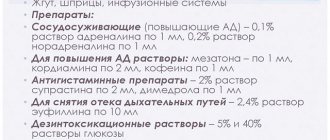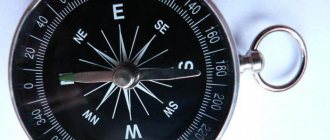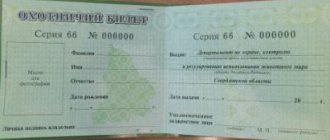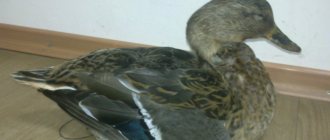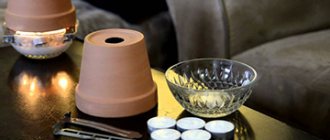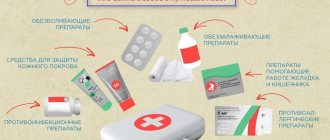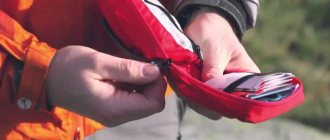Non-standard emergency rescue units (NARF)
As a rule, these are independent structures formed on a freelance basis, but equipped with all the necessary equipment, materials and tools to carry out emergency situations.
They are created on the basis of teams of government institutions and undergo special training courses on how to act in emergency situations. With these people, behavior algorithms are worked out, which must be memorized to the point of automaticity. Then certification is carried out, and if everything goes well, the unit receives permission from the Ministry of Emergency Situations to participate in eliminating the consequences of emergency situations.
civil defense
These are also non-staff formations created in each organization to carry out state civil defense activities. Their function is not associated with an immediate threat to the life and health of people during an emergency. But by providing all possible assistance, they help prevent an increase in the number of victims. Each civil defense unit has its own purpose:
- surveillance and reconnaissance (bacteriological, chemical, biological, engineering);
- debris removal;
- rescuers;
- technology;
- firefighters;
- protection (radiation, chemical, biological).
Individual first aid kit (AI-2) - is a standard means of providing self-assistance and mutual assistance in the event of injury or damage by weapons of mass destruction. The individual first aid kit AI-2 is included in the mandatory equipment list for non-standard emergency rescue units (NASF), which are part of the forces and means of Civil Defense and Civil Protection of Particularly Dangerous Enterprises, which are of important defensive and economic importance in accordance with Order No. 999 of the Ministry of Emergency Situations of the Russian Federation dated 23.12. .2005. Personnel of army units and other law enforcement agencies and emergency services are also equipped with first aid kits of this type.
Contents of the personal first aid kit AI-2 The medical first aid kit AI-2 includes a set of medical supplies consisting of 5 attachments:
· radioprotective agent No. 1 (cystamine 2 packs);
· antiemetic (etaperazine - 1 package);
· antibacterial agent No. 1 (tetracycline - 2 packs);
· radioprotective agent No. 2 (potassium iodide - 1 package);
· antibacterial agent No. 2 (sulfadimethoxine - 1 package).
Radioprotective agent No. 1, slot No. 4, two crimson pencil cases. If there is a risk of exposure to radiation, you must take 6 tablets with water. If there is a new threat of radiation, take another 6 tablets after 4-5 hours. Children under 8 years old are given 1.5 tablets per dose, and from 8 to 15 years old - 3 tablets.
Antiemetic, slot No. 7, blue pencil case. It is necessary to take 1 tablet immediately after irradiation, as well as if nausea occurs after a head injury. Children under 8 years old are given 1/4 tablet per dose, and from 8 to 15 years old - 1/2 tablet.
Antibacterial agent No. 1, slot No. 5, two unpainted pencil cases with square bodies. It is necessary to take the contents of one pencil case (5 tablets) with water in case of threat or bacterial infection, as well as for wounds and burns. Take the contents of the second pencil case (5 tablets) after 6 hours. Children under 8 years old are given 1 tablet per dose, and from 8 to 15 years old - 2.5 tablets.
Radioprotective agent No. 2, slot No. 6, white pencil case. Adults and children should take 1 tablet daily for 10 days after radioactive fallout, along with milk.
Antibacterial agent No. 2, nest No. 3, large pencil case without painting. It is necessary to take 7 tablets in one dose on the first day after irradiation if gastrointestinal disorders occur, 4 tablets in the next two days. Children under 8 years old take 2 tablets per dose on the first day, and from 8 to 15 years old - 3.5 tablets. In the next 2 days, children under 8 years old are given 1 tablet per dose, and from 8 to 15 years old - 3 tablets.
Remedy for FOV poisoning, slot No. 2, red pencil case. It is necessary to take 1 tablet upon civil defense signal. If signs of poisoning increase, you need to take another tablet. Children under 8 years old are given 1/4 tablet per dose, and from 8 to 15 years old - 1/2 tablet.
In Soviet times, the ai-2 first aid kit, in addition to the above-mentioned remedies, was equipped with an analgesic and a remedy for FOV poisoning. These substances belong to the category of narcotics, and for 20 years they have not been included in the AI-2 first aid kit during its production. These funds are invested by the consumer independently, if necessary, after receiving special permission and providing proper storage conditions.
Guaranteed shelf life - 3 years.
The individual first aid kit AI-2 is designed to equip every employee of all economic facilities of the Russian Federation, regardless of the form of ownership. The individual first aid kit AI-2 is included in the mandatory equipment list for non-standard emergency rescue units (NASF), which are part of the forces and means of Civil Defense and Civil Protection of Particularly Dangerous Enterprises, which are of important defensive and economic importance in accordance with Order No. 999 of the Ministry of Emergency Situations of the Russian Federation dated 23.12. .2005
GOST 23267-78
did you buy the ai-2 first aid kit? The average cost of this first aid kit is approximately 300 rubles.
Appearance
The AI-2 first aid kit is a plastic orange box, inside of which there are bottles with medications and a disposable syringe for their administration in two rows. In addition, the NASF received an individual anti-chemical package, a personal civil protection kit, anti-burn and dressing packages, a soft stretcher, and a sanitary bag containing a first aid kit.
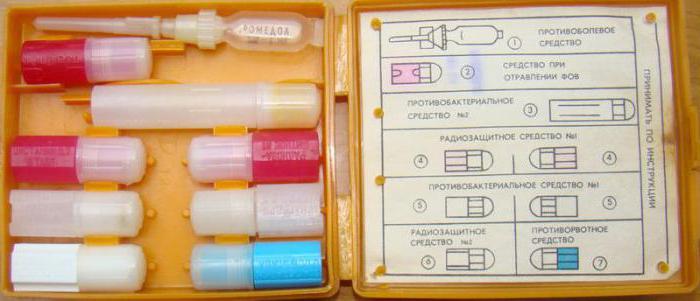
Since 2008, similar equipment, such as the AI-2 first aid kit, are no longer issued not only to army structures, but also to civilian units. Instead, there are AI-4 and AI-N-2.
All types of army medical kits
Depending on the composition and purpose, several options for army first aid kits have been developed:
- The individual first aid kit is characterized by ultra-compact dimensions and low weight. It is designed to be carried with you in case of emergency assistance in the field. AI-1 and AI-3 are used by the military, and AI-2 and AI-4 are used by civilians as part of civil defense.
- A military first aid kit is a more complete set of medical supplies designed to provide benefits to 4 victims. Military equipment - military vehicles, tanks - is supplied with military first aid kits. It contains antiseptic and dressing agents, antibacterial tablets for disinfecting drinking water, ammonia, and a tourniquet.
- The paramedic military kit is an expanded set of the military first aid kit, necessary for providing first aid to a large number of victims. A platoon or battalion must have such a setup. In addition, it is important to have a paramedic kit on evacuation routes, at civil defense and emergency headquarters.
- An individual dressing package is used to bandage wound surfaces, burns, and stop bleeding. The dressing bag contains a gauze bandage 9 cm wide with two cotton pads 15x15 cm. The first is tightly fixed to the bandage, the second can move freely along it. In case of a through wound hole, the first pad is applied to the area of the projectile entry, the second - to the exit area.
- An individual anti-chemical package is needed to neutralize toxic, irritating compounds that get on the skin, weapons, clothing, or gas mask. Can also be used for prophylactic purposes. Each military personnel must have an individual chemical protection package.
Compound
This is a list of drugs that the AI-2 first aid kit contains. Its composition may vary, so the average version is given.

- The painkiller is a syringe tube with a two percent solution of “Promedol” (morphine in some kits), the route of administration is intramuscular.
- The antidote for FOV (organophosphorus substances) is usually the drug “Taren”. A small red pencil case contains six tablets. To prevent poisoning, take one tablet and put on a gas mask. If symptoms such as miosis, blurred vision, shortness of breath do appear, you must take another tablet, but not earlier than six hours after the first.
- The antibiotic sulfadimethoxine is in the form of tablets in a sealed bottle. Taken for dysfunction of the gastrointestinal tract caused by a bacterial infection. A single dose is seven tablets, then four tablets every day.
- The radioprotective agent is Cystamine tablets. Taken for prevention from radioactive radiation. An hour before the expected radiation, you need to take six tablets; by the time of the threat, the effect will manifest itself, but if the duration of stay in the radioactive area exceeds six hours, the tablets must be taken again in the same dose.
- Broad-spectrum antibiotic – “Tetracycline”. It is taken not only for bacterial infection, but also after burns and injuries as a preventive measure. Single dose – five tablets. Take twice with an interval of six hours.
- Antiemetic - "Etaperazine". Instead, there may still be “Aeron”. Indicated after radiation exposure, as well as after concussions, traumatic brain injuries, poisoning, if nausea or vomiting occurs. Single dose – one tablet. The effect lasts four to five hours, if the symptoms do not go away, then you need to take one tablet every four hours.
- Potassium iodide tablets are a remedy that protects the thyroid gland from radioactive iodine. Take one tablet half an hour before the intended exposure or before eating radioactive foods. If you plan to spend more than a day in the radiation zone, then you need to take another tablet every 12 hours.
Table-1: Contents and purpose of the personal first aid kit AI-2
| No. Section Name Quantity | Compound | Purpose | Application |
| Section No. 1: One syringe tube with a white cap | Promedol | Powerful analgesic for fractures and severe wounds | For pain relief - intramuscular injection |
| Section No. 2: One pencil case with a red cap - 6TB. 0.3 g each | Taren | In case of poisoning with organophosphorus poisons | If there is a risk of poisoning, take 1 tablet, the next tablet after 5 hours |
| Section No. 3: One large colorless pencil case - 15 tablets | Sulfa-dimethoxine | For stomach upset after radiation exposure | The first dose is 7 tablets, the next day - 4 tablets |
| Section No. 4: Two octagonal red pencil cases - 12 tablets | Cystamine | Radioprotective agent No. 1, applied before exposure to radiation | You should take 6 tablets once, 30-60 minutes before possible irradiation |
| Section No. 5: Two tetrahedral colorless pencil cases - 10 tablets | Chlorine-tetracycline | Antibacterial agent Use for wounds, prevention of infection | You should drink 5tb once; After 6 hours, take 5 tablets again |
| Section No. 6: White tetrahedral longitudinal pencil case – 10 tab. | Potassium iodide | Radioprotective agent No. 2, used in case of accidents at nuclear power plants or radioactive contamination of the area | Take 1 tablet. once a day for 10 days. |
| Section No. 7: Blue pencil case with 5 tablets | Etaperazine | Anti-vomiting medicine | In case of concussion, accompanying for uncontrollable vomiting, take 1 tablet every 3-4 hours |
Features and Recommendations
The individual first aid kit AI-2, the composition of which is presented above, is somewhat outdated in its configuration. It does not contain modern antibiotics that could be used as a replacement for Tetracycline or Sulfadimethoxic, and there are also no sedatives. As practice shows, they are necessary in an emergency. Therefore, the civilian population is recommended to carry tranquilizers such as Sibazon or Phenozepam.

First aid kit AI-2 is designed for an adult. For a child under eight years of age, all doses should be divided into four parts, and for a teenager - into two parts.
Table-2: Composition and detailed description of protective equipment Personal first aid kit AI-2
| Compound | Start of action of the product | Duration of action | Side effects of the drug | Mechanism of action of the product |
| Promedol | Effect 10-15 minutes after injection | About 4 hours | Possible confusion, vomiting, decreased muscle strength | Exc. opioid receptors |
| Taren | Effect in 20 minutes | About 5 o'clock | Glaucoma, kidney and liver dysfunction | M and N-anticholinergic agent |
| Sulfa-dimethoxine | The effect begins in 30-60 minutes | The effect lasts about 1-2 days | Allergic reactions, vomiting, diarrhea, hepatitis | Blocks the synthesis of tetrahydrofolic acid |
| Cystamine | The onset of effect is usually 30 minutes after administration | About 5 o'clock | Burning sensation in the epigastric region, vomiting, drop in blood pressure | Neutralization of free radicals |
| Chlorine-tetracycline | The effect begins 1-2 hours after administration | About 6 o'clock | Stomach pain, diarrhea, vomiting, hypersensitivity reactions | Prevents the formation of the RNA + ribosome complex |
| Potassium iodide | The effect begins within the first day after administration | The effect lasts throughout the entire course of treatment | In rare cases, hypersensitivity reactions are possible | Prevents radioactive iodine deposition |
| Etaperazine | In the first two hours | Lasts up to 9 hours | Possible hypersensitivity reactions (allergy), coordination disorder | Dopamine receptor blocker |
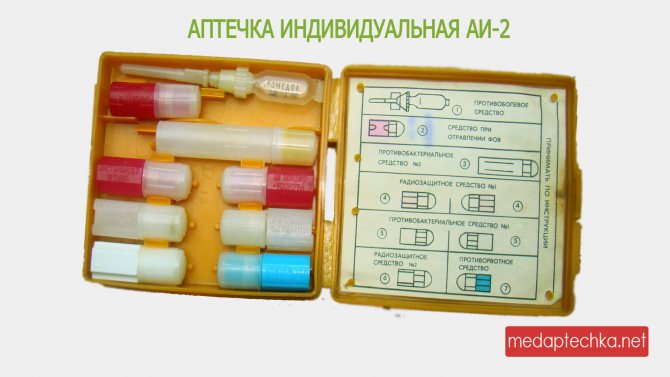
Download a detailed description of the protective equipment of the personal first aid kit AI-2 in the form of a table:
INDIVIDUAL FIRST KIT AI-2 DETAILED TABLE WITH DESCRIPTION AND APPLICATION 1 file(s) 41.00 KB
Download
At the moment, the first aid kit has no practical use. Production and use of AI-2 has been discontinued in the Russian Federation since 2012.
SEE ALSO:
INDIVIDUAL FIRST KIT AI-1 and AI-1M
INDIVIDUAL FIRST KIT AI-3 1BC
INDIVIDUAL FIRST KIT AI-3 2SP
INDIVIDUAL FIRST KIT AI-4
ARMY MILITARY FIRST KIT INDIVIDUAL
KIMGZ FIRST KIT - INDIVIDUAL MEDICAL CIVIL PROTECTION KIT
Modifications
The AI-N-2 first aid kit requires special mention. Special forces and other special military units use it for long-term autonomous use, as well as providing assistance to victims. It contains thirty types of drugs, compactly packaged in a small, convenient bag, which distinguishes it from the previous version.
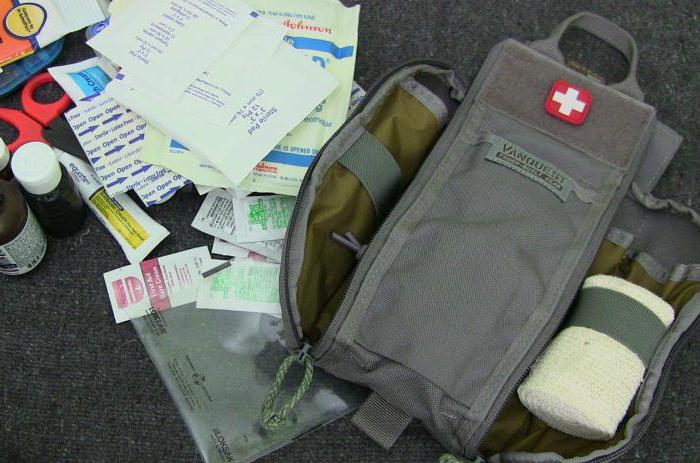
The AI-2 first aid kit has already been discontinued and can only be found as an exhibition item.
First aid kits AI-1 and AI-2 - as a symbol of the Cold War era
So, for the civilian population, as well as the police and other law enforcement agencies, there was a version of the AI-2 first aid kit, which included:
Individual first aid kit “AI-2” Antibacterial agent No. 2 (sulfadimethoxine 0.2 g) - 1 extended pencil case without coloring for 15 tablets; Radioprotective agent No. 2 (potassium iodide 0.125 g) - 1 white pencil case for 10 tablets; Antiemetic (etaperazine 0.006 g) - 1 blue pencil case for 5 tablets; Antibacterial agent No. 1 (chlortetracycline 0.006 g) - 2 unpainted pencil cases with square bodies for 5 tablets each; Radioprotective agent No. 1 (cystamine 0.2 g) - 2 crimson pencil cases for 6 tablets each; The drug Taren containing the substance aprofen - an antidote to FOS - 1 pencil case for 6 tablets; Also, the first aid kit could be equipped with a syringe tube with a narcotic analgesic - promedol.
Perhaps this was not the best combination of medications, but it was produced in tens of millions of kits and, when used correctly, made it possible to reduce the exposure dose of penetrating radiation several times (with the advance use of Cystamine).
“Cystamine” binds free radicals and some enzymes, giving them resistance to the disruptive action of ionizing radiation.
Radioprotective No. 1 “Cystamine”
In the second stage, the drug “Potassium iodide” was taken to prevent the absorption of the Iodine-131 isotope from the atmosphere (arising during the nuclear chain reaction of Uranium-235 or Plutonium 240, 241, 242), due to the advance oversaturation of the thyroid gland with the iodine drug (then it becomes immune to Yoda-131).
Radioprotective No. 2 “Potassium iodide”
The USSR Civil Defense was preparing to protect the country's civilian population
Those who received very large doses of radiation, close to lethal, and who experienced uncontrollable vomiting or diarrhea had to take the antipsychotic “Etaperazine” (a brother of “Aminazine”, widely used in psychiatry of those years), it suppressed the gag reflex and, in general, the amount of any nervous impulses (convulsions, convulsions and desires to move) was reduced to a minimum - this was supposed to alleviate both the suffering of the affected person (in fact dying) and a little calm those with whom such a person (or such people) found themselves in the same shelter (including through they take the same drug, but more on that below).
Antiemetic drug "Etaperazine"
If, in addition to vomiting, a person also began to have diarrhea (as a result of the division of pathogenic intestinal microflora), then he took a sulfonamide antimicrobial drug - “Sulfadimethoxine”. It is also applicable for some purulent infections, bronchitis, pneumonia, open wounds, inflammation of the urinary tract and even bacterial meningitis.
Antibacterial agent No. 2 “Sulfadimethoxine”
“Chlortetracycline” is one of the first tetracycline antibiotics; currently it is used almost nowhere except in veterinary practice, but it has proven effective against anthrax and plague.
https://docs.cntd.ru/document/9046526
Later it was replaced by a more promising and powerful antibiotic “Tetracycline hydrochloride” (the list of pathogens also includes: unspecified cholera, unspecified plague, anthrax and a whole bunch of lesser ranks)
https://www.rlsnet.ru/mnn_index_id_82.htm
Antibacterial agent No. 1 “Tetracycline hydrochloride”
"Taren" ("Aprofen") is an M-anticholinergic blocker and a standard antidote for poisoning with organophosphorus toxic substances (OPS), such as "Sarin", "Soman", "Tabun", "Vi-Gases" or their mixtures, as well as derivatives of esters of methylphosphonic and ethylphosphonic acids and compounds based on the most toxic “Tammelin esters”.
"Taren" ("aprofen") has a strong antispasmodic, vasodilator effect, relaxes smooth muscles.
FOV antidote - "Taren"
In addition to its main purpose - blocking biotargets, FOV can be used (and at one time was used) in obstetric practice: to stimulate labor, while simultaneously increasing uterine contractions, “aprofen” reduces spasm of the pharynx and promotes faster dilatation of the cervix in the first stage of labor.
Those. Soviet “militarists,” when creating an antidote pill, immediately came up with several purposes for it (including peaceful ones), this particular one was supposed to make it easier for Soviet women to give birth at high stages in a bomb shelter, where it’s cold, dark, scary, and there’s uncertainty above (i.e. .i.e. terrible stress, when this woman may not have a single living relative left at home, and the deadline has come, she must give birth).
"Promedol" is a synthetic analogue of "Morphine". I will say right away from my own experience that I had to undergo an operation under “promedol”. Rhinoplasty surgery, i.e. I had to unscrew the bone and cartilage in my nose, remove the damaged fragment from under the mucous membrane and lower the mucous membrane back.
10 minutes before the operation, I was injected with promedol intramuscularly, I did not feel any euphoria or dullness of consciousness, I was even slightly afraid that they had injected me with some kind of glucose.
But there was nowhere to go, I sat down in a chair, and they injected me with a local anesthetic. And the operation began. I was completely conscious, I felt, rather realized, how pieces of bone were being chipped out of me with a chisel, how cartilage was being broken out with tongs, but there was no pain. No local anesthetic is capable of this. I was conscious throughout the entire operation and did not understand how one could experience something like this without feeling pain.
After the operation, I was taken to the ward and was injected with another “promedol” for the night. His nose was stuffed with bandages and he was breathing through his mouth. I don’t remember any “sweet narcotic dreams”, I just remember the absence of pain and some relief.
Syringe tubes with “Promedol” are stored separately from first aid kits and are placed in them immediately before/after an emergency or on the eve of war and major battles.
A syringe tube with “Promedol” is placed in an individual first aid kit so that the person does not die from painful shock.
Remember, a few years ago, in winter, a Ka-52 crashed near the airfield? He fell almost nearby, but at night he was not found until the morning due to a blizzard. And the crew, at least one pilot, died due to painful shock; he was alive for some time, but could not survive until the morning. And if there had been a syringe tube with Promedol in the pocket of the flight suit, then the pilot would have stood up and waited for the morning, and perhaps he would have overcome it and provided assistance to the co-pilot or given a signal to the search and rescue group.
A person who has received a bullet wound or a mine explosion injury, or a person with an open fracture of a limb, or a person who has received burns over 40% of the body, or a person dying from radiation exposure, spitting out his intestines through his mouth... This is who cannot survive without “Prom” or will die in terrible agony, and those around him will do nothing to make his passing easier.
Those. even this small amount, collected in AI-2 on the scale of the USSR, could give colossal results and save millions of lives (if the civil defense and emergency response algorithms were worked out and the protective structures were in good working order) and hundreds of thousands of worthy deaths.
The AI-1 first aid kit appeared a little earlier (not much)
Individual first aid kit AI-1
It was intended exclusively for military personnel of the Ministry of Defense and due to its limited volume it could be called modular, i.e. in addition to the constant composition, it could be supplemented, for example, with a tranquilizer - “Phenazepam” and an antidepressant - “Ftoratsizin” (war is not a toy for you, there are suicides and manic-depressive psychoses and nervous breakdowns, which can lead to grave consequences in the form of executions of one’s own units .And in war, no one's roof goes crazy, this one can simply tear it off the house and carry it the fuck away. And so it goes for everyone, some faster, some slower, so half of them are depressed You can’t remove it from the front, but you can put some on the wheels to hold the roof a little stronger).
But what surprised me most was the drug “Afin” in a syringe tube, as an antidote to FOV (in the AI-2 first aid kit it was replaced by tablets called “Taren”), because this witch’s potion, in addition to a mixture of M-anticholinergics, contains a psychostimulant - “Amphetamine” , which the Wehrmacht gave to its tank crews, Luftwaffe pilots and Kriegsmarine submariners, and their feelings of fear and fatigue were dulled, and the pain threshold also increased. Hitler himself was heavily addicted to amphetamine and got half his army hooked on methamphetamine.
So the side effects of Athena include hallucinations and memory loss during the action, lack of awareness of one’s actions, which can lead to unpredictable consequences.
The antidote of FOV "Athenes", into which, for some seditious purpose, in addition to the M-anticholinergic drug, the psychostimulant "Amphetamine" was added, which in the slang of club youth was called "Hairdryer".
My classmate once told me his brother’s story that in 1995, before they were thrown out somewhere closer to the center of Grozny, they were injected with something. I suspect that this something was “Athens”. Because they ceased to be people, their consciousness became animal, they simply settled in the house, took up defensive positions, shot at all the running figures, without discerning whether they were theirs or strangers, everything was as if in a fog, they did not distinguish between insignia, gender and age, racial identity, they did not want to eat or drink, there was no fear. It was as if zombies were attacking their house from all sides. (Unfortunately, in fact it was the other way around). Only automatic and machine gun fire at those who were walking, running, crawling. Alone or in groups. At that moment it made no difference. Just faceless figures, like in a shooting gallery, that appeared and disappeared. And then it began to let go, the waste started, blood, meat, bodies, before my eyes. Who did it? We did it?
Some AI-1 first aid kits contained another antidote, Budaxim, instead of Athena.
Antidote FOV "Budaxim"
It consists of M- and N-anticholinergics, a peripheral cholinesterase reactivator - "Dipiroxime", a central cholinesterase reactivator - "Damoxime".
Perhaps in the army you need a psychostimulant, perhaps at a post when you have to stay awake for several nights or in a raid, when you need to run for several days with a backpack in the rain or sleet, it will save lives, but then you need a pure psychostimulant that does not cloud the brain and not clouding the mind. A stimulant that opens the body's internal physical and mental reserves and rebalances its capabilities in order to maximize the release of energy for action, while supplying the brain with oxygen and increasing its activity (reaction, logic, irrational thinking, etc.)
Now, when all leading countries, alliances and armies are preparing for an inevitable war, the creation of a civil and military first aid kit at a fundamentally new level is a matter of national survival.
Instead of the obsolete "Cystamine", I propose to install a pencil case with a radio protector "B-190"
The drug B-190 ensures the survival of 9 out of 10 irradiated people at an absolutely lethal dose; today it is the most effective radioprotector.
It is used as a service radio protector by NPP and Rosatom employees.
Potassium iodide for protection against iodine-131 can (should) be retained, but it would be nice to develop (if feasible) protection against strontium-90, which is close to calcium and therefore is absorbed by the skeletal system causing extremely severe radiation injuries (affecting the bone marrow and red blood cells).
A combination drug that protects against iodine-131 and strontium-90 could save even more lives and prevent the development of incurable diseases, as well as mutation of offspring.
Instead of the antiemetic neuroleptic "Etaperazine", I suggest using the broad-spectrum antipsychotic "Chloroprotexen"
in a dosage of 0.25 or 0.35 mg tablets (6-8 tablets)
Psychoses, including schizophrenia and manic states, occurring with psychomotor agitation, agitation and anxiety; paroxysms of excitement associated with fear and tension; dyscirculatory encephalopathy, traumatic brain injury, withdrawal syndrome in alcoholism and drug addiction; hyperactivity, irritability, agitation, confusion in elderly patients; sleep disturbance in anxiety states, premedication, anxiety (including in patients with burns), pruritic dermatosis, bronchospasm, vomiting, pain syndrome (in combination with analgesics). In child psychiatry: psychosomatic and neurotic disorders, behavioral disorders in children.
“Etaperazine” could also do a lot of this, so they were going to not only stop vomiting, but also stop hysteroid conditions in women, psychosis, collective panic (they just didn’t write about this in the leaflet, so as not to provoke people who were no longer quite adequate, especially if, against the background of their sluggish mental disorder, they had been abusing alcohol for some time before (hour “X”), such people, to varying degrees and at different stages, will always find themselves in any group during any emergency or emergency and will begin to rage there, sow chaos and panic , don’t kill them for their behavior and don’t leave them “overboard” outside the shelter, just turn them off with medication and isolate them if possible), but this is a drug from the 60s, weaker and more severe in terms of tolerability and side effects. There is a newer and more effective one.
In the civilian version of the first aid kit, I suggest leaving “Taren” (“aprofen”) as an antidote for FOV, and in the military version, a syringe tube, using a combination of “Atropine” and “BZ”
.
It was “BZ”, the full name of Benzilate-3-Quinuclidol, that was found in the blood of the Skripals, then everyone mistakenly made a fuss that “the British press was confused in the testimony.”
But in fact, “BZ”, in addition to being a psychotomimetic agent (causing temporary hallucinations and disorientation in space and time), is also a model M-anticholinergic blocker.
And judging by the fact that the Skripals did not die in the first hours, days and possibly weeks, “BZ”
as an antidote to OPA, it has proven itself more than worthy, especially if we are talking about a representative of the most toxic group of organophosphorus compounds ever created in the laboratory.
https://lenta.ru/news/2018/01/08/hattab/
Instead of "Chlortetracycline"/"Tetracycline" I suggest "Josamycin"
, it has such a wide list of pathogens (including anthrax, diphtheria, whooping cough, scarlet fever, erysipelas, syphilis, pneumonia without specifying the pathogen, and many, many others) that it is better to read the link:
https://www.rlsnet.ru/mnn_index_id_35.htm
The second antibiotic in the sulfonamide group, instead of sulfadimethoxine, I suggest “Co-trimoxazole”
(from a short list of pathogens: unspecified cholera, typhoid fever, gonococcal infection, wound infections without specifying the pathogen)
https://www.rlsnet.ru/tn_index_id_3859.htm
Or the second antibiotic could be a combination of Oleandomycin + Tetracycline
The description of the combination itself is quite sparse: https://www.rlsnet.ru/mnn_index_id_4407.htm
It is better to look separately at what it is: “Tetracycline”: https://www.rlsnet.ru/mnn_index_id_82.htm
And what is it: “Oleandomycin” https://www.rlsnet.ru/mnn_index_id_513.htm
And then you will have a general idea of the synergy of these two drugs combined in one form:
I tried to depict a general list of indications under the cut:
Actinomycosis. Bronchitis. Pneumonia. Diphtheria, unspecified. Brucellosis. Conjunctivitis. Urinary tract infections. Gingivitis. Stomatitis. Otitis media Pharyngitis. Sinusitis. Psittacosis. Blue disease. Q fever. Syphilis. Trachoma. Dysentery. Angina. Whooping cough. Scarlet fever. Gonorrhea. Tularemia. Epidemic relapsing fever. Bacterial endocarditis. Purulent meningitis. Cholecystitis. Skin and soft tissue infections. Cholera, unspecified Anthrax, unspecified Plague, unspecified Pneumonia, unspecified causative agent. Pleurisy. Lung abscess. Empyema of the pleura. Bronchiectasis. Tonsillitis. Otitis. Scarlet fever. Whooping cough. Trachoma. Protracted endocarditis. Meningitis unspecified. Sepsis (staphylococcal, streptococcal, pneumococcal). Osteomyelitis. Furunculosis. Enterocolitis. Infections of the urinary and biliary tract (if the liver parenchyma is not affected).
In addition to antibiotics, the new first aid kit should include antiviral drugs and immunomodulators (the pandemic has already demonstrated this to the whole world)
In my opinion, the fairly fresh drug Ferrovir
https://www.rlsnet.ru/tn_index_id_18132.htm
Those. one of the most powerful at the moment, which is used, among other things, for the treatment of hepatitis C, complex therapy of immunodeficiency conditions caused, incl. oncology and HIV.
If there is a more powerful or comparable domestic analogue, then I’m all for it. But so that this does not actually turn into a waste of budget money with the creation of a drug that is an order of magnitude inferior in effectiveness to the Western model.
And the domestic antiviral drug “Triazavirin”
which is currently being tested against coronavirus:
The active substance of the drug Triazavirin is a synthetic analogue of purine nucleoside bases (guanine) with a pronounced antiviral effect. It has a wide spectrum of antiviral activity against RNA-containing viruses.
The main mechanism of action of the drug Triazavirin is the inhibition of the synthesis of viral RNA and the replication of genomic fragments.
For the military, if they need a psychostimulant in one bottle, they can turn to the thousand-year history of the Incas, namely to Coca, no, I’m not talking about synthetic “cocaine hydrochloride”, although the Germans tried to use it for the pilots of their single-seat sabotage submarines.
There are other alkaloids:
"Ecgonine": Increases endurance, regulates oxidation processes and enhances fat burning "Globulin": stimulates blood circulation, treats fear of heights "Pyridine": stimulates blood circulation, improves oxygen supply to the brain and muscles "Inulin": increases the production of hemoglobin "Coca m"
in": analgesic, blocks pain, does not dull other senses.
Mix them and get a universal remedy that increases combat effectiveness, endurance, attention, dulls pain and fear.
